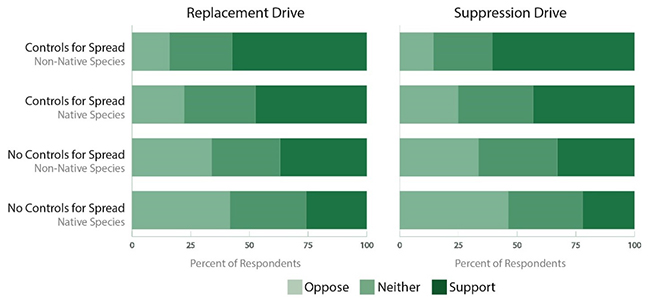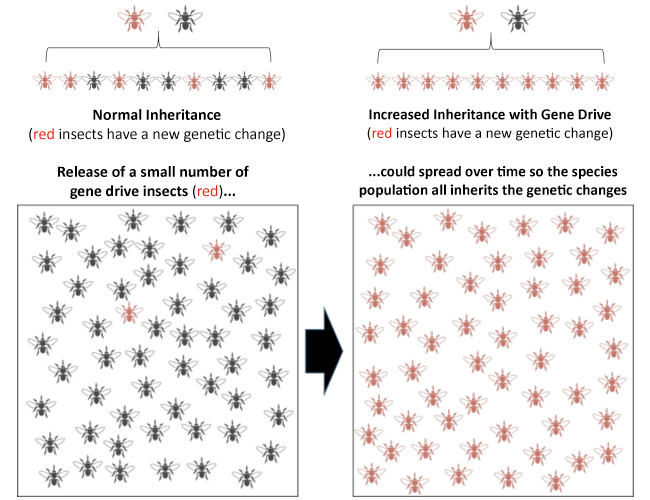
Written by: Mike Jones | See Related Science Advances ARTICLE and NC STATE NEWS PRESS RELEASE
Few technologies have inspired the level of excitement and apprehension as gene drives.
Imagine – the release of only a small number of genetically engineered organisms could suppress populations of a pest species or spread a desired trait, such as the inability to transmit malaria. The idea was conceived years ago but has recently risen to the forefront of conversation with the discovery of new genetic tools as well as success (and challenges) with experimental cage trials. The list of potential gene drive applications is immense, targeting some of humankind’s greatest biological challenges: blocking mosquitos from spreading malaria or dengue fever, wiping out invasive mice in remote islands to save native plants and animals, and controlling damaging and costly invasive agricultural pests. Inspired by “selfish genetic elements” found in nature, most engineered gene drive approaches leverage the much-touted CRISPR/CAS gene-editing system to overcome natural rules of inheritance. This could provide an efficient way to make strategic genetic changes in a pest species population, drawing cautious cheers from some and apprehension from others.
How does a gene drive work?
Genetic barriers are overcome so all offspring inherit a trait, which could then spread rapidly through the species population, whether regionally or even further.
Engaging publics on novel technologies
Breakthrough technologies such as gene drives have risks and uncertainties that must be scrutinized and understood. The premier US research body, the National Academies of Sciences, Engineering and Medicine (NASEM), commissioned a special report in 2016 titled “Gene Drives on the Horizon: Advancing Science, Navigating Uncertainty, and Aligning Research with Public Values.” The report first recommends that research on gene drives continues, both in improving the performance of the technology and assessing its risks. The NASEM report also emphasizes the importance of early and persistent engagement with communities, stakeholders, and the public in deciding whether and how to use the technology. International bodies are also thinking carefully about this topic, with the European Food Safety Authority (EFSA), the International Union for Conservation of Nature (IUCN), and the Organization for Economic Cooperation and Development (OECD) commissioning workshops, task forces, and specialized working groups to try and untangle thorny regulatory and governance questions. Yet despite these public engagement and governance efforts, the technology’s development is growing more rapidly than our understanding of the ecological, legal, social, and economic implications of deploying these organisms. Nor do scientists and policy-makers have a clear sense yet of how the public might judge the use of this technology for different aims and by different interests.
Gene drives for agricultural pest control – what do people think?
Agriculture is distinct from health or environmental applications in that insect releases serve a primarily commercial purpose. Farmers in multi-billion dollar industries are facing serious challenges from invasive species like Spotted Wing Drosophila, a fruit fly which can lay eggs inside ripening berries, and Asian citrus psyllid, which spreads the bacterium causing the hugely destructive citrus greening disease. Gene drive insect releases could potentially help farmers save money on control costs for invasive pests, reduce pesticide spraying, and also reduce prices for consumers. However, the commercial (and environmental) benefits of releases must be weighed against risks, which may take the form of ecological unintended consequences or adverse market, trade, or public reactions, among other factors.
Would the American public support the use of gene drive to tackle agricultural pests? In a recent study published in the journal Science Advances, our team at North Carolina State University’s Genetic Engineering & Society (GES) Center, along with colleagues at University of Wisconsin-Madison, worked to help answer this question. The interdisciplinary team included Agricultural Economists (Michael Jones, Zachary Brown, and Paul Mitchell), a Science, Technology, and Society (STS) scholar (Jason Delborne), and an Entomologist (Johanna Elsensohn). In this study, we conducted three focus groups that preceded the first nationally representative survey (n=1,018) to gauge the United States public’s support and/or opposition to a variety of designs for gene drive systems related to agricultural insects. We first informed respondents on how gene drives work, then provided detailed information about potential risks, benefits, and illustrations of the proposed spotted-wing berry pest and citrus psyllid applications. We measured support and opposition along three key design and targeting dimensions which were identified in focus groups and within the 2016 NASEM gene drive report: 1) whether the spread of the gene drive is designed to be limited vs. allowed to spread through any geographic territory of that pest (e.g., ‘limited’ vs. ‘unlimited’ spread), 2) whether the pest targeted is a non-native vs. native species, and 3) whether the drive system is designed to alter populations which then remain in growing areas but cannot carry a crop disease vs. a system which suppresses populations and removes them from growing areas (i.e., ‘replacement’ vs. ‘suppression’ drive).
The most impactful design factor on public support was the use of strategies with limited, more controlled spread of gene drive systems. This factor increased the percentage of respondent support at almost twice the rate of targeting non-native vs. native species and over ten times the rate of using a replacement vs. suppression drive system. Overall, support for targeting non-native species via ‘limited’ drive systems with controlled spread was 57-60%, with 14-16% explicit opposition.
US public support for Gene Drive Use in Agriculture
Figure note: Respondents were asked whether they support or oppose the use of gene drives to control agricultural insect pests in each of eight applications, with condensed Likert response frequencies varying 1) whether controls are in place to limit the extent of drive spread, 2) whether the target species was native to an area, and 3) whether the design is a ‘replacement’ or ‘suppression’ drive. A ‘replacement’ drive may alter an organism to block it from carrying a crop disease and this modified version remains in the environment. A ‘suppression’ drive may alter an organism, for example, to prevent female offspring from developing normally and thus crash the population over time, and is generally intended to locally or broadly eradicate the species. Source: Jones et al., Sci. Adv. 2019;5: eaau8462 (Fig 1a).
In addition to design factors, we also examined what respondent characteristics correlate with support or opposition to drive systems. While few traditional demographic factors impacted support, identifying as the household’s ‘primary shopper’ and recently purchasing blueberries or orange juice (the two products mentioned in examples of drive insect applications) increased support by about 4-5 percentage points. We also find that approximately 1 in 5 Americans seek out ‘non-GMO’ labeled food. We hypothesized this could correlate with opposition to use of genetically engineered insects in growing areas. Not surprisingly, this group is about 9 percentage points less likely to support using gene drive insects – the biggest impact from a single consumption behavior variable. However, the plurality of individuals seeking ‘non-GMO’ labeled products still report overall support for self-limiting drive systems in non-native species. This percentage of support slightly exceeded 50% (with about 26% explicitly opposing, about twice the rate of the rest of the population). So, given these responses from groups actively seeking out ‘non-GMO’ labeled foods, there appear to be fundamental differences in how the public reacts to different uses of plant- vs. insect-based biotechnologies in the food system.
Challenges, opportunities, and uncertainties with ‘area-wide’ gene drive pest control
The reality is that area-wide release of gene drive insects – potentially across multiple counties, states, or countries – means interaction with both conventional and organic production systems. In a pest management sense, this non-chemical control could be great news for organic growers who are documented to face disproportionately higher losses and costs from damaging invasive species. But all farmers face markets, and there needs to be more clarity from organic certification bodies on how this would be handled, in addition to a better understanding of how organic consumers may react. Approximately one in five respondents indicate they regularly purchase certified organic foods. Almost 44% of these organic food consumers agree that farmers should be able to retain organic certification when gene drive insects are present in the area (vs. 28% disagreeing). This drops to 35% agreement when genetically modified drive insect material gets ‘in or on crops’ (vs. 39% disagreeing). This is certainly not a uniform response pattern and may present tough decisions for certification bodies. The fact that only 57% of these regular organic purchasers are even aware that some types of insecticides are allowed under organic regulations likely complicates perceived trade-offs between reducing pesticides and accepting levels of drive insect presence. Agreement levels differed by up to 15 percentage points depending on this awareness. So, yes, it’s complicated. And this complicating nuance may be the source of sticking points in a commercially-applied technology which comes with many potential advantages and drawbacks, even if it’s fully developed and deployed by a more trusted public sector entity.
A critical moment to incorporate public feedback on gene drive systems
At the moment, we have not arrived at the decision point on whether to release gene drive insects, either for agriculture or any other application. But many scientists want to design technologies which are more likely to see real-world deployment, and it is tougher to deploy a technology which may face an uphill battle – not unlike, for instance, the recent controversy around proposed genetically engineered (non-drive) Aedes aegypti mosquito releases in the Florida Keys. In the meantime, it is necessary that researchers address the legitimate questions posed by experts and the public, recognizing that questions prioritized by experts may not always satisfy the broader population.
Many of our respondents (70% of the sample) invested survey time in learning more about “possible risks of gene drives,” so the interest is clearly present. And in a ranking exercise, the public heavily prioritizes resolving questions about human health and potential environmental impacts. In fact, these items received significantly higher priority than questions about cost-effectiveness and ‘reversibility’ of drive interventions, factors that may be prioritized by economists and scientists. This might imply the public is willing make sacrifices in cost-effectiveness for more controllability of the drive system (since limited drives require more frequent releases, among other factors). This may also imply a need to communicate more concrete answers to questions arising in focus groups, such as “Could a modified insect cause illness in humans?”
These complex questions take time and resources to address. However, this investment, coupled with a concerted effort to maintain complete transparency and trust with the public, may ultimately have a real impact on whether these technologies are judged acceptable for deployment.
—
Acknowledgments – We thank Fred Gould, Roderick M. Rejesus, and faculty and student affiliates of the NC State Genetic Engineering and Society Center for helpful comments which improved survey design, statistical analysis, and writing of the study manuscript. We thank Khara Grieger and Patti Mulligan for helpful comments on this blog piece. This research was funded by the U.S. National Institute of Food and Agriculture grant number 2017-67030-26778 and HATCH project NC0250 and by the National Science Foundation award numbers 1068676 and 1533990.
